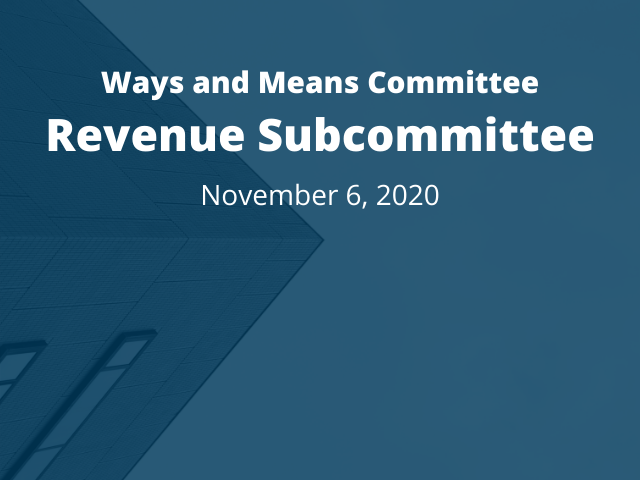George Butler, Jr., Policy Analyst, Department of Legislative Services
Robert Rehrmann, Policy Analyst, Department of Legislative Services
Overview of Tax Credit Evaluation Act
- Since the mid-1990s, the number of State business tax credits has grown significantly as have related concerns about the actual benefits and costs of many of these credits.
- Although tax credits comprise a small percentage of total income tax revenues, the number and amount of credits claimed have significantly increased over time.
- The total amount expended for credits has increased from a little less than $50 million in tax year 1994 to about $300 million in tax year 2019.
- In response to concerns about the fiscal impact of tax credits on State finances, Chapters 568 and 569 of 2012, the Tax Credit Evaluation Act, established a legislative process for evaluating certain tax credits.
- The evaluation process is conducted by a legislative evaluation committee and must be done in consultation with the Comptroller’s Office, the Department of Budget and Management, the Department of Legislative Services, and the agency that administers each tax credit.
- The committee is appointed jointly by the President of the Senate and the Speaker of the House of Delegates and must include at least one member of the Senate Budget and Taxation Committee and one member of the House Ways and Means Committee.
- Section 1-303 of the Tax – General Article specifies the schedule for conducting evaluations of tax credits in accordance with the Act.
- July 1, 2014 – Enterprise Zone and One Maryland economic development credits;
- July 1, 2015 – Earned Income and Film Production Activity credits;
- July 1, 2016 –Sustainable Communities Tax Credit (now designated the Historic Revitalization Tax Credit Program);
- July 1, 2017 – Businesses That Create New Jobs and Job Creation credits;
- July 1, 2018 – Research and development expenses and biotechnology investment incentive tax credits;
- July 1, 2019 – Regional Institution Strategic Enterprise (RISE) Zone Program;
- July 1, 2021 – More Jobs for Marylanders tax credit;
- July 1, 2023 – Cybersecurity investment incentive and purchase of cybersecurity technology or service tax credits.
- Generally, the continuation of a tax credit designated for evaluation is for a 7-year period and the credit is subject to reevaluation 7 years after the previous evaluation.
- By June 30 of the year prior to a tax credit’s evaluation date, the evaluation committee is required to meet with the Comptroller’s Office, DBM, DLS, and the agency that administers the credit to prepare a plan for evaluation.
- By November 15 of the same year, DLS is required to publish a report evaluating the tax credit that discusses:
- the purpose for which the tax credit was established;
- whether the original intent of the tax credit is still appropriate;
- whether the tax credit is meeting its objectives;
- whether the goals of the tax credit could be more effectively carried out by other means; and
- the cost of the tax credit to the State and local governments.
- By December 31 of the same year, the evaluation committee must hold a public hearing on the evaluation report, at which the public may submit testimony.
- By the twentieth day of the legislative session before the evaluation date of a tax credit, the committee is required to submit a report to the General Assembly.
- The report must state whether or not the tax credit should be continued, with or without changes, or terminated and shall be accompanied by any legislation that is needed to accomplish the recommendations in the report.
Challenges in Executing Tax Credit Evaluation Act
- The statute does not reflect the actual practice for how evaluations have been conducted
- Although the evaluation committee is tasked in statute to meet with specified agencies to prepare a plan for an evaluation, DLS has undertaken the responsibility to consult with these agencies.
- The timeline for evaluations prescribed in statute may not be practical under some circumstances
- With respect to new programs, DLS has found some deadlines to have been set too early and therefore lacked sufficient data to conduct a thorough evaluation of the program
- In other instances, statutory deadlines may not be ideal when coinciding with recent statutory changes to a program
- The statutory deadlines for publishing reports may not provide an adequate period of time for stakeholders to comment on findings and recommendations
Proposed Alterations to Tax Credit Evaluation Procedures
- During the 2020 legislative session, this committee undertook an effort to examine multiple tax credit programs.
- As part of that effort, leadership of the committee and this subcommittee engaged DLS to craft a different way going forward that would ensure that the General Assembly continues to receive the information that it requires to evaluate the effectiveness of the State’s tax credit programs but also allow DLS to more dynamically respond to inquiries by the legislature about specific components of tax credit programs or other tax incentives.
- The newly revamped Joint Audit and Evaluation Committee statute served as a model to the proposed alterations.
- As amended by this committee, House Bill 565 altered the Tax Credit Evaluation Act by:
- Eliminating the Tax Credit Evaluation Committee and instead requiring DLS to conduct evaluations on request from the Senate Budget and Taxation Committee, House Ways and Means Committee, Executive Director of DLS, or Director of the Office of Policy Analysis of DLS;
- Expanding the scope of the TCEA to include not only tax credits but also tax exemptions and preferences; and
- In light of the expanded scope of the program and the requirement for DLS to conduct evaluations on request, removing the schedule of evaluations to be conducted from statute.
Q&A
Delegate Eric Luedtke: Does DLS track how often the recommendations and the reports have actually been implemented?
Robert Rehrmann: We don’t have a tracking mechanism for those recommendations.
Ryan Bishop: The first couple of years we did these evaluations it took a bit of time for the legislature to review what we were doing. We made a lot of recommendations but the legislature really wasn’t ready to tackle some of them period there were really structural changes to the credit, as the evaluation process went on though there were a number of recommendations that the legislature adopted.
Delegate Jessica Feldmark: If there are recommendations for certain tax credits not to sunset, what alternative is there to really push the question of giving it a proactive evaluation and reconsideration?
Ryan Bishop: We have always advocated to the legislature that tax credits have sunsets. Some of these tax credits were created as long ago as the mid to late 1990’s. If they didn’t already have a sunset on them, it is oftentimes tough to get a sunset on them because you have the advocacy groups. We hear from the business community that when you sunset things or you place budgetary limitations on credits, that can cause businesses to shy away from claiming the credit.
Josh Goodman, Senior Officer, The Pew Charitable Trusts
Why evaluate tax incentives?
- Tax incentives are one of states’ primary economic development tools.
- Tax incentives collectively cost states billions of dollars per year.
- Evaluation is a proven way to improve the effectiveness of incentives.
- With tax incentives, the details matter.
A well-designed evaluation process should…
- Regularly examine all major economic development tax incentives.
- Provide lawmakers with reliable, detailed information and analysis.
- Lead to improvements to incentive policy.
- Allow for refinements to the process over time to ensure that it is meeting the needs of policymakers.
High-quality evaluations include…
- A description of the incentive, its history, and its goals.
- An assessment of the incentive’s design and administration.
- An estimate of the incentive’s economic and fiscal impact.
- Policy recommendations.
Observations About Maryland’s Evaluation Process
- The evaluations are detailed and high-quality.
- The scope of the process is narrow.
- Evaluations could contribute to policy discussions and changes more consistently.
Options to Make a Broader Scope Manageable
- Allow for expedited reviews when warranted.
- Consider whether new evaluations are necessary for programs the state has studied previously.
- Reduce the frequency of evaluations.
- Increase staffing for evaluations.
Evaluation Schedule Options
- Group similar programs together.
- Evaluate programs prior to sunset dates.
- Allow for flexibility.
Strategies to Elevate Evaluation Findings
- Hold legislative hearings on evaluations.
- Use sunset dates.
- Communicate findings to executive agencies.
- Conduct follow-up reviews.
Washington State’s New 10-year Schedule: Considerations
- Industry grouping
- Amount of the preference
- Expiration date of the preference
- Whether the legislature explicitly directed a review of the preference
- Whether the preference is considered critical to the state’s tax structure
- Results of previous reviews
Q&A
Delegate Julie Palakovich Carr: At the forefront of the process, when we are creating tax credits, there might be things we could be doing as a best practice from other states to ensure we have what is needed in the enacted law to be able to have a good evaluation. There may be information from other states that can help us in that direction.
Josh Goodman: We’ve done some research on this, and there are states that are working on that. For example New Mexico and Maine.
Delegate Julie Palakovich Carr: Is there anything that we could be doing in terms of how we structure tax credits in law to ensure that when local governments have key reporting requirements so that we can do full evaluations?
Josh Goodman: Data is certainly one of the critical limitations. I think it really is a mix of using creative approaches to study programs even when you don’t have data you can still look at the design of the program. Also using evaluations as an opportunity to improve data.
George Butler: Reporting requirements have been strengthened to provide data in the future and to the legislature data on a more regular basis so that can shape the legislature’s actions.
Delegate Jessica Feldmark: In the review I think some credits are more explicit about their intended outcome and purpose. Is that part of the best practice checklist you just spoke of?
Josh Goodman: Yeah it is part of that checklist and it’s something other states do.
Senator Melony Griffith: Have they come up with a way to capture those one-off benefits?
Josh Goodman: There are a couple things that come to mind. When you’re evaluating these programs it’s helpful to distinguish if it’s a specific project you’re building. When you do economic analysis of these programs it is really important to consider both the positive and negative indirect benefits.
Delegate Eric Luedtke: How many of our credits if any actually include language stating measurable objectives for those credits in the statute? Is that something that is popped up?
George Butler: I would say yes, it’s not common. Offhand I don’t have an exact number, some of the more robust credit programs do not include that information.




